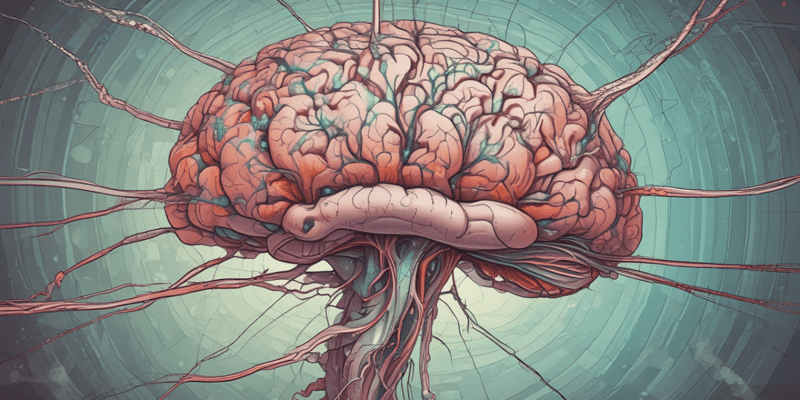5 Questions
Compare and contrast the structural and functional divisions of the Central Nervous System (CNS) and Peripheral Nervous System (PNS).
The CNS consists of the brain and spinal cord, integrating and processing information, while the PNS consists of nerves and ganglia, transmitting information between the CNS and the rest of the body. The CNS is protected by the blood-brain barrier, whereas the PNS is not. Functionally, the CNS is responsible for higher-level functions, such as thought, emotion, and control, while the PNS is responsible for transmitting sensory information and controlling motor responses.
What are the primary functions of oligodendrocytes and Schwann cells in the nervous system?
Oligodendrocytes myelinate axons in the CNS, while Schwann cells myelinate axons in the PNS, allowing for faster transmission of nerve impulses.
Describe the role of voltage-gated sodium channels in the generation of an action potential.
Voltage-gated sodium channels allow for a rapid influx of sodium ions, depolarizing the membrane and generating an action potential.
Outline the events associated with synaptic transmission, including the role of neurotransmitters and their receptors.
- Neurotransmitter release from the presynaptic neuron, 2) binding to receptors on the postsynaptic neuron, 3) activation of ion channels, and 4) generation of an action potential or synaptic response.
Compare and contrast the effects of serotonin (5-HT) and GABA on neural activity.
Serotonin (5-HT) is an excitatory neurotransmitter, increasing neural activity, while GABA is an inhibitory neurotransmitter, decreasing neural activity.
Study Notes
Central Nervous System (CNS) and Peripheral Nervous System (PNS)
- CNS consists of the brain and spinal cord, integrating and processing information
- PNS consists of nerves that connect CNS to the rest of the body, transmitting information
Types of Cells in the Nervous System
- Neurons: responsible for receiving, integrating, and transmitting information
- Glia: provide support, protection, and maintenance functions for neurons
Generation and Transmission of Nerve Action Potential
- Depolarization: rapid change in membrane potential, allowing sodium ions to rush in
- Repolarization: slow change in membrane potential, allowing potassium ions to rush out
- Important ions: sodium (Na+), potassium (K+), and chloride (Cl-)
- Ion channels: control the flow of ions across the membrane, regulating the action potential
Synaptic Transmission
- Synapse: gap between the terminal end of one neuron and the dendrites of another
-
Events of synaptic transmission:
- Neurotransmitter release from the terminal end
- Binding of neurotransmitters to receptors on the postsynaptic neuron
- Generation of a new action potential in the postsynaptic neuron
Neurotransmitters
- Acetylcholine: involved in muscle contraction, memory formation, and regulation of the autonomic nervous system
- Adrenaline/Noradrenaline: involved in "fight or flight" response, increasing heart rate and blood pressure
- Dopamine: involved in reward, motivation, and movement
- Serotonin (5-HT): involved in mood regulation, appetite, and sleep
- GABA: inhibitory neurotransmitter, reducing neuronal activity
- Glutamate: excitatory neurotransmitter, increasing neuronal activity
- Substance P: involved in pain transmission and modulation
Test your knowledge of the central and peripheral nervous systems, including neural cells, action potential, synaptic transmission, and neurotransmitters.
Make Your Own Quizzes and Flashcards
Convert your notes into interactive study material.
Get started for free



